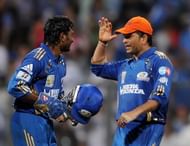Sometimes, the universe makes things crystal clear. Ambati Rayudu undoubtedly had talent – very obvious, visible talent; talent that screamed out for attention, talent that forced you to sit up and take notice, talent that took your breath away.
In 2001, the coaches in the Mecca for budding cricketers in India, the National Cricket Academy in Bangalore, suddenly had a new conversational ice-breaker – Ambati Rayudu’s unbelievable batting prowess. They said that the next Sachin Tendulkar had been unearthed, and that in a few years’ time Rayudu would gift India her first Test triple century, that it would be a royal disappointment if this lad did not go on to make 8000-odd runs in Test Cricket. After all, this sixteen-year-old was different from other cricketers – he was blessed.
In 2002, Rayudu hammered a commanding, unbeaten 177 against England in an under-19 match on a seaming track in Taunton. The coaches were over the moon, and cricket followers in the country were in celebratory mode. In the Ranji season that followed, he smashed a double ton and a ton in the same match – all at the tender young age of seventeen. In 2004, he went on to astutely captain Team India to the semi-finals of the under-19 World Cup in Bangladesh. More praises were heaped, and greater the expectations grew.
Ambati Rayudu was clearly tailor-made for success – he had all the right ingredients. His technique was compact, his stroke-play fluent, his temperament solid, and his work-ethic admirable. There was no doubt that Rayudu would go on to play for India, they said. It was just a matter of time, they said.
Sometimes, things just go your way. Sometimes, things just magically fall into place. Ambati Rayudu, though, was never that fortunate. The horrid combination of bad decisions and treacherous luck stalked Rayudu for most part of his career – it ensured that he could never reach the zenith of his incredible potential, and could never become the batsman the country expected him to become.
Halfway through a disappointing 2004/05 season, Rayudu was unable to see eye to eye with the Hyderabad coach and had a feud with the Hyderabad Cricket Association. He got himself transferred to Andhra Pradesh for the next season, but never felt completely at home there. Back with Hyderabad in 2006/07, he had issues with the umpires on a few occasions. He ran into trouble with Arjun Yadav, who allegedly attacked him with a stump. Gradually, Rayudu’s rock-solid temperament seemed to have worn off, and most of his supporters mentally prepared themselves for the crushing numbness that disappointment brings.
By 2007, Ambati Rayudu was a lost soul – a beaten man. While Rayudu was still feeling his way around in the wilderness, many of his under-19 team mates were already playing for India. When the rebel Indian Cricket League came calling, Rayudu viewed it as a golden opportunity – the prospect of rubbing shoulders with retired international cricketers and playing in front of a live television audience attracted him to no end. However, his contract with the ICL meant that he would be banned from BCCI tournaments, and all doors seemed to have shut on any possibility of him donning the India colours.
Following the failure of the Indian Cricket League, Rayudu accepted the BCCI’s amnesty offer in 2009 and cut off all his links with the now-defunct ICL. Mumbai Indians signed him up in 2010 for the third season of the Indian Premier League, and he impressed immediately. He soon became the only uncapped regular in a star-studded Mumbai line-up. 356, 395 and 333 runs in IPL seasons 3, 4, and 5 respectively brought Rayudu back into the limelight. He showcased his obvious class on an international platform, and stunned the world by fearlessly going after the best of bowlers.
Meanwhile, his Ranji Trophy records quickly improved as well. The flow of runs from his blade, which had earlier slowed down to a trickle, became a gush. His decision to move to Baroda seemed to have worked for him; in the 2010/11 season, he scored 566 runs from 9 games at a healthy average of 56.60, including a typically stylish double century. In the 2012/13 season, Rayudu plundered 666 runs at 60.54. He was successful in the 2013 Irani Trophy, as well as in the 2012/13 Deodhar Trophy.
To traditional batting aficionados, Rayadu was still a visual treat. The lazy elegance was still there, and so was the effortless poise. His batting stance still had a slight hint of arrogance, and his strokes still possessed the sheer magic of timing. Slowly but surely, Ambati Rayudu was crawling his way back into the Indian scheme of things.
And earlier this month, when MS Dhoni’s medical report said that he would be unavailable for selection for the Zimbabwe tour, as well as the rest of the West Indies tour, the Sandeep Patil-led selection committee needed to find a replacement. They did not have to look too far – Ambati Rayudu had been knocking on the doors for a long time now. While he may not get a chance in the well-oiled Indian middle order currently playing in West Indies, it is almost certain he will make his debut in the second-string Indian team touring Zimbabwe later this month.
It may have taken much longer than he thought it would, it may have been a rough journey, and it may have been a path littered with obstacles. But ask Ambati Rayudu, and he will say it has been worth it.
Get real-time updates on IPL 2025, live scores, IPL Prediction, match schedule, points table,Result & squad -CSK, MI, RCB, KKR, SRH, LSG, DC, GT, PBKS


